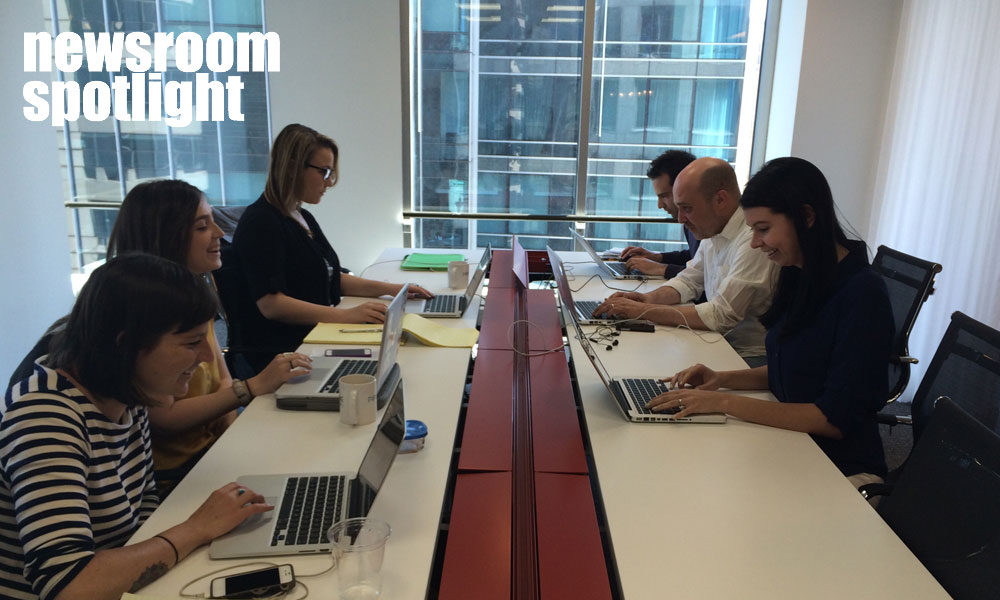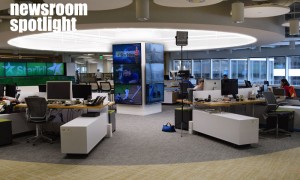Editor’s Note: This Q&A is part of “Newsroom Spotlight,” a series of conversations with journalists about what’s going on in their newsrooms and the media industry. The interview excerpts have been lightly edited and organized for clarity.
Jim Brady had grown tired of news organizations trying to preserve their legacy products while also trying to appeal to a new generation of news consumers.
So the digital news veteran decided to go all in with a startup of his own aimed squarely at the younger generation: Billy Penn, a mobile-first platform based in Philadelphia that formally launched in October 2014.
Brady, 47, brings to the venture two decades of experience with digital news, a stretch that included stops as executive editor of washingtonpost.com, general manager of TBD.com, editor-in-chief of Digital Media First and a number of executive roles at AOL.
In its first six months, Billy Penn has focused on innovating new storytelling methods to engage with people under 35 and provide that audience with ways to participate in important social movements. Last week’s deadly Amtrak crash tested his team and drove a lot of traffic to Billy Penn; its coverage for each of the three days immediately following the derailment rank among the top 10 days since it launched.
American Journalism Review caught up with Brady to discuss Billy Penn (owned by Stomping Ground, his new company,) its approach to digital media and his views on the changing climate in journalism.
American Journalism Review: Tell me about the size of your newsroom operation. How many employees are on your editorial staff and how much news do those employees produce through various channels?
Our newsroom staff is four, I guess four-plus if you include me. …I’m more on the business side. …Each of them curates for three hours a day, kind of reading through other stuff that’s being written about Philly, and then reports for five hours — if they work eight-hour days, which they don’t. They work pretty hard. But that’s the general breakdown of the time. We produce three [or] four original pieces a day and curate the rest.
AJR: What key experiments are currently underway at Billy Penn?
Brady: [We’re] trying to figure out how to connect news to social action, so [we’re] covering a lot of stories in which the average citizen has a lot of opportunities to take the next step, which is to volunteer for something or sign a petition. Right now, we’re building up the sort of functionality that will go with that.
Assume you’re reading a story; you’ll be presented with more options on how to get involved in this particular topic. And I think that, for us, is the ultimate experiment. At this point, we’ve been experimenting mostly with our storytelling forms. We’ve been having a lot of fun with emojis. We do a weekly Philly news playlist, where we pick 10 to 12 songs that kind of go along with the news of the week. We kind of use it as a way to recap the week of news while also getting Spotify playlist downloads. …We’re just playing around with lots of different ways to communicate information to an audience that doesn’t necessarily want it in strict headline-text format.
AJR: For you personally, what’s your motivation behind pursuing that type of storytelling?
Brady: I don’t think we’ve ever encountered a generation of news consumers as different as the generation that’s coming up now. They certainly are interested at times in getting stories in a traditional text format, but I think they’re also much more open and, in a sense, demanding of stories that get pulled to them in ways that are non-traditional, which is why we’ve done what we’ve done. And that’s why you see so many people playing around with Meerkat and Periscope and Snapchat and whatever the hot thing of the moment is.
For me, I didn’t feel like you could really pursue this generation of news consumers while you were at a company that was trying to preserve a legacy product, because I just think they’re too different, and I don’t think you can try to address both with one strategy. So I just decided to break away from the legacy business and start my own thing.
AJR: How does Billy Penn approach packaging stories for the web and for mobile?
Brady: We focus on mobile first. The whole site was designed for a phone or a tablet, and how it looks on the web is kind of secondary to us. We spent very little time designing the desktop version of it and a lot more focusing on how it would look on mobile. And I think when you focus on mobile you have to focus on different stats. You have to focus on load time. You have to focus on ad experience. I mean you have people in a very unique experience, and they’re not interested in getting drowned in ads or waiting for a page to load. They’re task-oriented and impatient. So I think when you package stories, you’ve got to take that into account. You don’t want to build something that’s going to be ornate and take 15 seconds to load, because you’ve probably lost that reader by that point.
In a lot of cases, you’re on a mobile phone and you’re standing on line at Starbucks or sitting at a traffic light and really just trying to find out what’s going on. And in this particular case, Philadelphia, you don’t want to spend 3 minutes digging. If we can, by curation, provide a good user experience and update you on what’s going on in the city in 30 seconds, then we should be happy trying to do that and not overload the site with a lot of stuff. So we try to make the storytelling form entertaining [and] relatively straightforward.
AJR: How do you feel about how your team did in covering the Amtrak crash?
Obviously, we got a little bit of a head start on the story because one of our staffers was on the train, but I think we established ourselves as a good source for reasons that went beyond that.
I thought we handled it really well and showed how powerful curation plus original reporting can be in a major breaking news story. Instead of rushing to write your own stories every time there’s a press conference, or any other development, we looked at what angles we thought weren’t being covered and used our own resources there, and kept our readers updated by linking to others who were filling other gaps.
I still think that’s the power of curating – which, by the way, in my definition, is linking out, not rewriting another news org’s story and stealing a link. Curating serves the reader first, and I’d still argue most news organizations haven’t done that as well as they should. Between bad load times, cluttered user interfaces and an unwillingness of most to link to other relevant information, I think readers are open to finding other sources,and we’d like to continue to be one of those.
We still believe in the role of gatekeeper, but instead of deciding what gets published and what doesn’t, we’re now sitting downstream a bit and surfacing the best reliable content to our readers, source be damned.
AJR: What do you think is the most innovate thing Billy Penn has done since its launch?
Brady: In terms of storytelling, we’ve translated a couple of the gubernatorial debates into emojis. We could just repeat what the candidate says, which is what everybody else was doing on Twitter, or you could have some fun with it and try to translate it. We did the same thing with [Philadelphia Gov.] Tom Wolf’s inauguration speech. We did the same thing with all the endorsements of the election. We kind of reviewed all the endorsements from all the major news organizations in Pennsylvania and instead of just headline [and] link, we used a certain number of thumbs up to indicate the strength of the endorsement and an emoji to show which of the two candidates were endorsed. And I think it got a lot more attention because we did it that way, rather than just running a classic headline-and-link kind of thing.
The playlist has certainly been something that’s gotten a lot of attention around town as a clever way to communicate news to people…couched in music. So those are both done very well.
One of the little things that’s been kind of fun and is something with storytelling is we created an emoji for each of the mayoral candidates and got them all to actually sign them because they all really liked them. So we have, hanging on the wall of the office, signed emojis from all the mayoral candidates. That can sound kind of light, but…it’s a way to connect with those particular candidates. We’re the new guy in town. We don’t necessarily have the long history in the city to be able to pick up the phone and interact with mayoral candidates. But by doing something like this, we got attention from them, we got noticed by them, and now we’re participating in a couple mayoral debates. …So I think sometimes a clever way to communicate is not just limited to what you do on your site, but it’s how you get the word out about what you’re doing offsite and building your brand.
AJR: Why did you guys pick emojis as a storytelling device to focus on?
Brady: We’re going after the 35-and-under audience. That’s been our strategy from the beginning. And certainly that is a staple of your typical mobile communication, using emoji. And I think it’s a clever way to take advantage of the fact that we’re not running around with a staff of photographers. In some odd way, maybe it’s the 2015 version of the Wall Street Journal’s sort of pixelated drawings they’ve been doing of people for 100 years… Obviously we had a designer do those for us, a freelance designer, who was fabulous. We’ve chosen a lot of different ways of doing it. Every time we sit down or cover a big story, we’re looking for some clever way to communicate that story to people. And so far, that’s been one of the ones that’s worked the best.
We’re [also] trying to get word out of what we’re doing in town, and we did a couple of bracket sort of countdown things in which we get the readers to vote. We did ‘what’s the ultimate Philly thing?’ — a soft pretzel, a cheese steak, Benjamin Franklin, the Philadelphia Phillies, Reading Terminal Market. So we had a bracket where people just voted over the course of a month [on] what the ultimate Philly thing was. And we just did another one picking Philly’s all-time greatest athlete. It’s a way to get people to participate in a conversation and in a debate and let them drive the winners. And so we’re going to continue to do more of those. And we’ve got a great partnership with the Fox affiliate here in Philly, who worked with us on the athletes bracket and put our logo up on their broadcast every Friday for about five minutes for a month, and that was great for us.
AJR: What kind of emerging technologies are you trying to learn more about because they have the potential to impact news?
Brady: Periscope and Meerkat and those kinds of things. We’re going to do some Snapchat experimentation in the next month or so. I think we’ve looked at WhatsApp, that’s a little more complicated. …We’ve already done a fair amount of stuff with Vine. Obviously, we’re all over social media, and we’ve used Storify and all the tools associated with that. The key is just understanding what those tools are and trying one or two things with each of them to see if you can sort of place it in the proper context. People cry all the time that there’s always a new tool around the corner, but if you really believe in journalism and storytelling, you should not be pooh-poohing arrival of new tools; you should be excited about them, because each one opens up a new opportunity…
AJR: What kind of audience development efforts are underway at Billy Penn?
Brady: We really view events as the crucial part of our business model. I think we’re a little bit different from your average local site, which is we have ads, we enjoy having ads, but we don’t want to have so many of them that the user experience gets corrupted.
So we are focused on trying to drive some ad revenue for sure, but we’re really focusing on using the convening power of the news organization to have events. So we’ve had three events, and each one of them has had a sponsor. …We really feel that’s the way to grow the audience and grow the reputation, is to be associated with events that are interesting and entertaining, and then use the ad revenue as a secondary source of revenue. …We’ve also done meet Billy Penn nights where that staff goes to a bar somewhere, so if anyone wants to come pitch a story or complain about a story or suggest a new one, they can all just show up there and meet with the staff. …Those have been popular too.
AJR: What exactly were those three sponsored events?
Brady: The first was a celebration of our first three Who’s Next list honorees, held at the Union Trust on January 26. It also served as a de facto launch party for Billy Penn. We had about 275 people in attendance. The second was an event at Comcast about How to Find — and Keep — Tech Talent in Philly, where we had more than 100 to network and hear a panel featuring a local startup, Comcast and a rep from the city. The third was The Pew Charitable Trusts presenting the findings of its annual State of the City report. We had more than 75 at that event. We will soon be holding an event to honor our Who’s Next in education winners. We had food and drink at each of the events. At the first party, we had a voter registration station, and at the second, we did a verbal job fair, where any attendee could get up and announce any open jobs they had. At the education event, we’re planning a school supply drive as well. We always like to have something beyond the core event.
AJR: Can you elaborate on the Billy Penn business and revenue model?
Brady: [We have] no plans for any kind of paywall for the stories we report out or for the curation. I’m not a paywall guy. We are looking at membership as a line of revenue, but are still working through the details and structure of that. As for profitability, we’re looking at that coming in early- to mid-2016. It’s still a way off, but trending the right way.
AJR: As far as the social media protocol with the staff, how much onus do they put on promoting stories?
Brady: We have more referral traffic from social than any other source by a significant amount. Twitter and Facebook have both been equal but different sources. Twitter tends to be our steady, every day referral traffic, and Facebook tends to be a little bit more spike here and spike there and a little less consistent. But our philosophy, frankly, is: be aggressive on those platforms. Don’t just write a headline and put out a link. Write with some voice. Write like you’re talking to somebody across the table rather than traditional journalism headline, which can be a little boring and a little dry.
AJR: Do you have plans to expand Billy Penn to other cities?
Brady: Yes, I would like to eventually expand into other cities, but not until we’ve really worked through the initial concept here and have it on that path to profitability. As for what other cities, I have lots of ideas on that, but keeping it to myself for now.
AJR: On a scale of 1 to 5, how optimistic are you about the future of news — 5 being very optimistic, 1 being not optimistic at all?
Brady: I’m 4. I’m pretty optimistic about it. If we’re optimistic about news, 4; if we’re optimistic about newspapers, probably 1, because I think those two things have to be separated out. A lot of people struggle still to separate them. The future of news is going to be fine. People still want news. People are interested in news. There’s no sign that the younger generation is interested in news less than previous generations, it’s just they got it from a lot of different sources, depending on subject and location. But they’ll always want news….I do think there may be an end for a lot of newspapers, but I don’t think that’s the same thing.
People get into this ridiculously obsessive love affair with the format of how [news] is delivered rather than what’s being delivered, which is journalism, right? If journalism is the water that flows through the pipes, who cares about pipes? Just make sure I have water.









